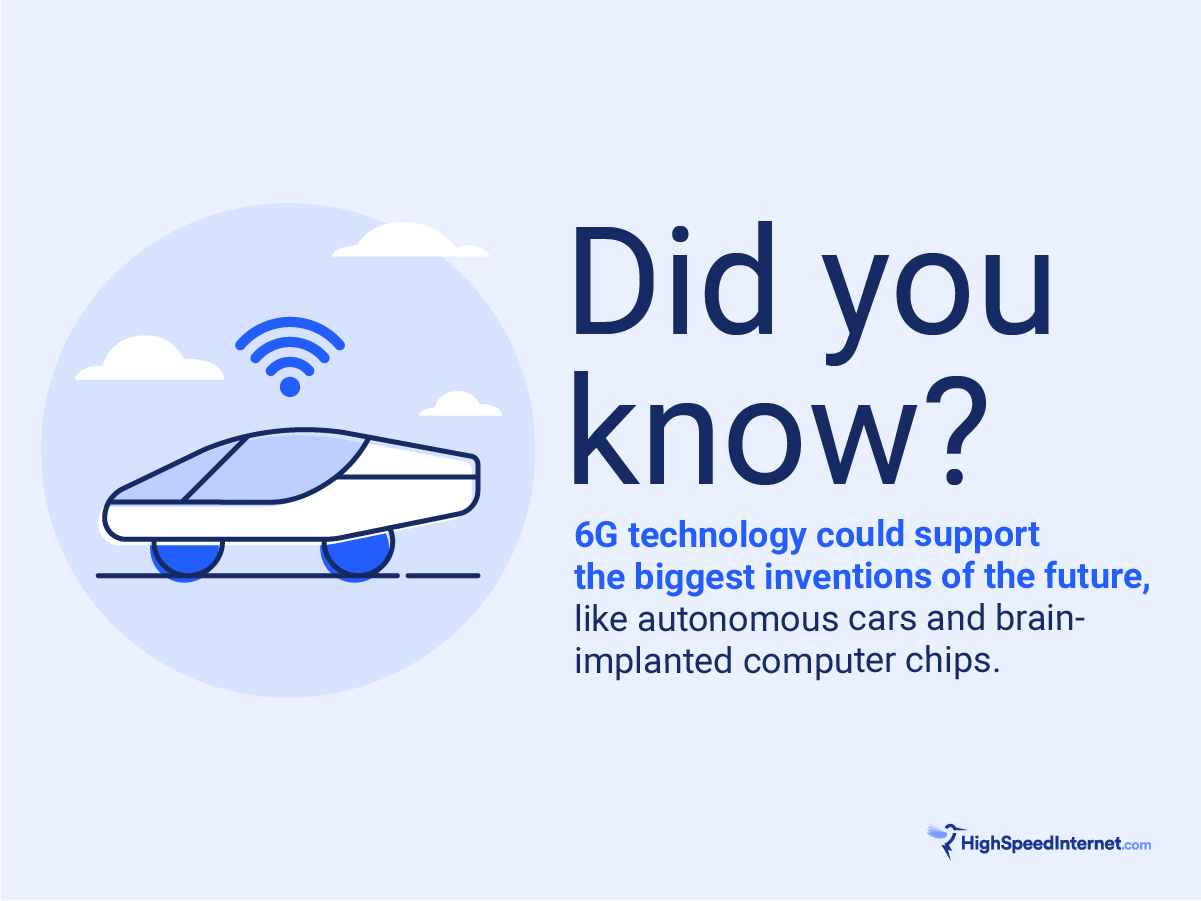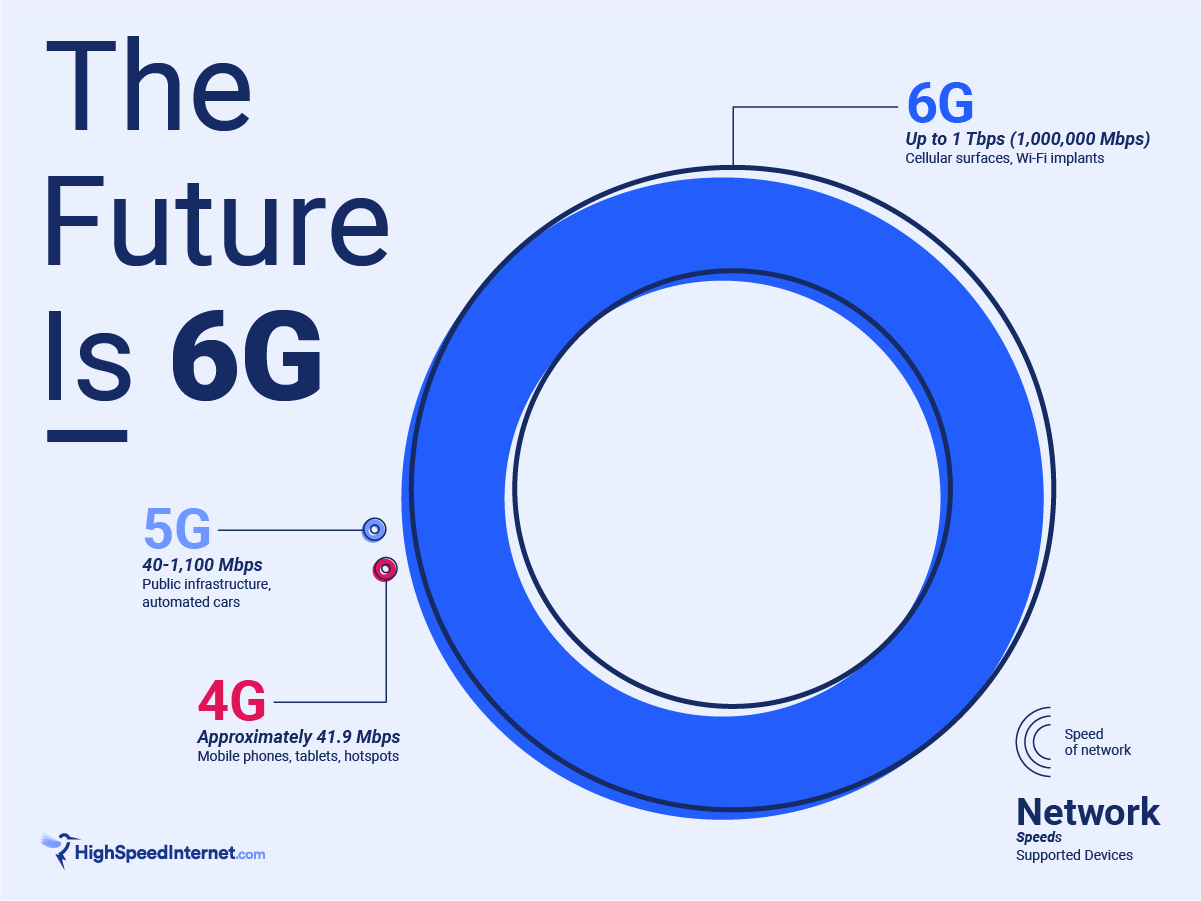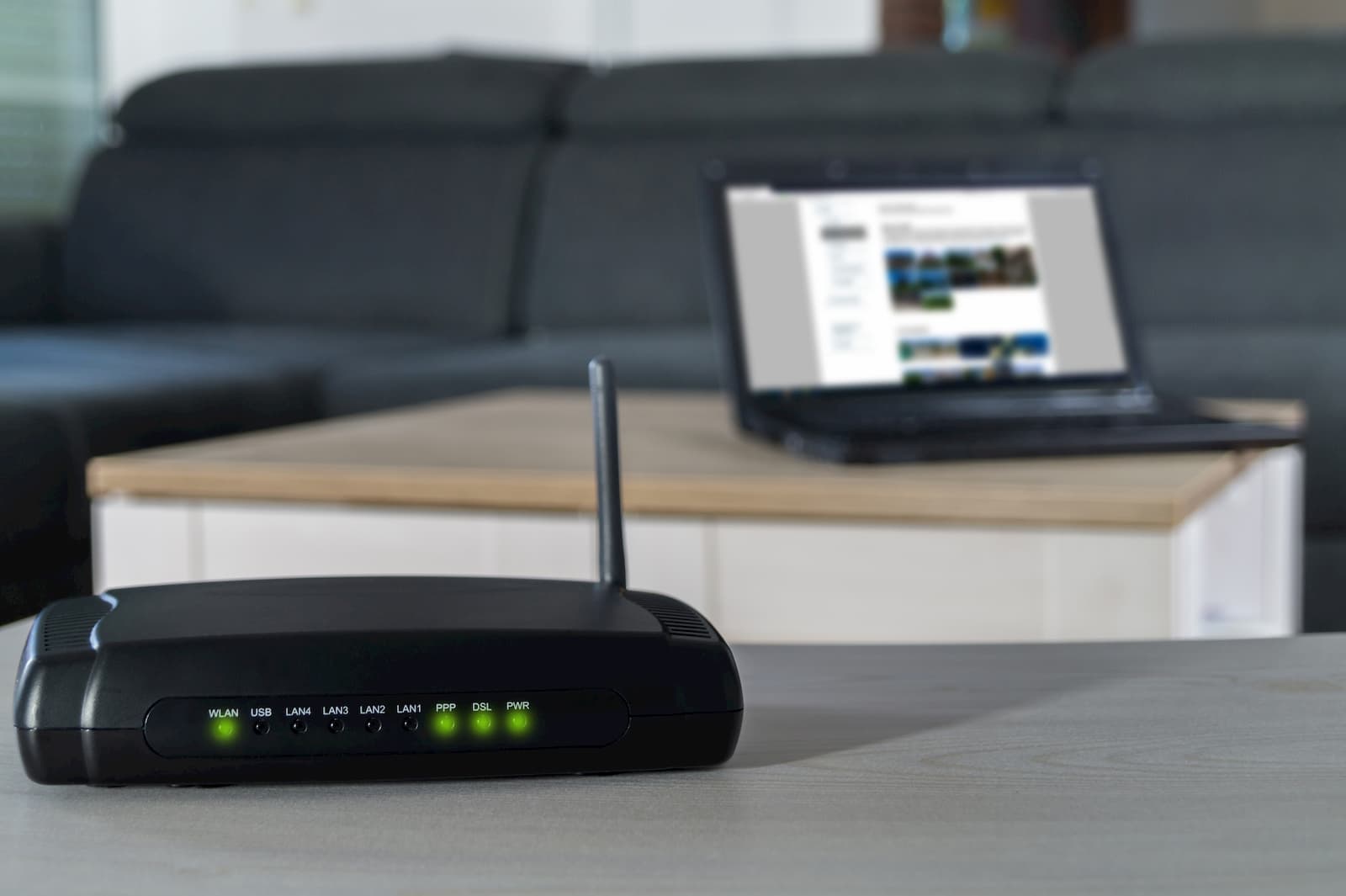What Is 6G and What Will It Look Like?
Sep 5, 2023 | Share
Brand Guides
Even though 5G wireless networks are still in the early stages of deployment, wireless communication companies are already looking ahead and thinking about the next mobile network to come. It’s called 6G.
Technically, 6G doesn’t exist yet. But as experts imagine it, 6G is the next phase of wireless technology, incorporating novel approaches like edge computing, artificial intelligence, and terahertz waves to help make a completely new type of internet. Internet speeds could end up a thousand times faster than what internet users get now. Latency could drop to as low as one millisecond. Standard Wi-Fi devices like laptops and phones could make way for cutting-edge tech like cellular surfaces and Wi-Fi implants. (Yes, implants.)
This is all purely theoretical right now, of course. But a growing interest in the subject has led to government investments in research and partnerships between universities and telecommunications companies. So let’s take a deep dive into the world of 6G and imagine what the future holds.
Shopping around for new internet?
Enter your zip code below to see which providers are available in your area.
What is 6G?
6G is the sixth generation of wireless technology. A 6G network follows up on 4G and 5G, using higher frequency bands and agile, cloud-based networking technology to deliver record-breaking speeds and microsecond latency.
According to research papers and telecommunications experts, 6G takes technology originally meant for mobile phones and applies it to a much wider set of uses, including transportation, healthcare, agriculture, and smart-home networks. In the process, average people will begin to experience a seamless connectivity between the internet and everyday life.
What will be the benefits of 6G?
The main benefit of 6G is its ability to facilitate instantaneous communication in phones, computers, wearable devices, robotics, and more. As we discuss farther down on this page, technology like terahertz waves and edge computing will allow for widespread implementation of wearable smart devices, metaverse tools, automated infrastructure, and other things we haven’t even dreamed of yet.
“What happens is the connectivity becomes like air,” said Kaniz Mahdi, Vice President of Advanced Technologies at cloud computing company VMware, in a Skype interview with HighSpeedInternet.com. “Just imagine if you have that level of connectivity—what is the impact to society? What is the impact to our daily lives?”
That’s the idea, anyway. 6G (as it’s envisioned right now) is going to take a lot of work to implement. It will require buy in from major stakeholders too, including a public that may be resistant to radical technological change.
When will 6G be available to consumers?
6G is expected to be available around 2030. That’s the estimate of most experts, considering that new wireless communication standards emerge about every decade. But nothing is set in stone—even the term “6G” might at some point fall out of favor and be replaced by something else.
Pro tip:
If you’re still unclear about what 5G is, then see our 5G guide for an explanation of why it’s significant.
What will 6G look like?
It’s hard to say what 6G will look like—after all, it doesn’t exist yet. But in media interviews and research papers, wireless companies and academics describe 6G as a fully integrated, internet-based system that allows for instantaneous communications between consumers, devices, vehicles, and the surrounding environment.1,2
Right now, we have the Internet of Things (IoT) with smartphones and smart home devices. Eventually we could arrive at an all-encompassing Internet of Everything. But that will depend on future developments like 6G (or whatever it will be called) and how it works.
Here’s a rundown of what experts are talking about when they talk about 6G:
1 Tbps speeds
Some experts believe that 6G networks could one day allow you to hit max speeds of one terabit per second (Tbps) on an internet device.3
That’s a thousand times faster than 1 Gbps, the fastest speed available on most home internet networks today. It’s 100 times faster than 10 Gbps, the hypothetical top speed of 5G. So, yeah, it’s a rosy guesstimate, and we are a long way off from achieving those speeds.
Fundamentally, though, researchers predict that 6G will place an emphasis on extremely high bandwidth and reliability. On 6G, internet will be instantly and continuously accessible, woven for many of us into the tapestry of everyday life.1
Terahertz waves
In 2019, the Federal Communications Commission (FCC) opened the gates to a potential 6G future by allowing companies to begin experimenting with what’s being called “terahertz waves” or “submillimeter waves.” These are radio bands that fall in the spectrum of 95GHz to 3THz (terahertz).
Terahertz waves come at a higher frequency than millimeter waves, which today are being touted as a kind of Holy Grail solution to network congestion and bandwidth limitations. Advanced versions of 5G depend on millimeter wave bands to carry vast amounts of data at ultrafast speeds with minimal response time, making it (theoretically) possible to develop things like automated cars and remote surgeries.
The catch is that millimeter waves work only over short distances, requiring a “line of sight” between the transmitter and the user. And terahertz waves have even weaker range. But if they can be properly harnessed with some novel networking approaches, it can open up even more capacity for doing sophisticated, Jetsons–esque activities over a 6G wireless network.
Artificial intelligence and edge computing
Automated cars and drones, remote-controlled factories, and other uses of artificial intelligence (AI) have been getting a lot of discussion amid the rise of 5G. The advent of 6G is expected to make this even more of a thing—and some experts think artificial intelligence will be required to keep it all coordinated and running smoothly.
Razvan-Andrei Stoica and Giuseppe Abreu, two researchers at Jacobs University in Bremen, Germany, said that 6G could rely on “collaborative AI” to help self-driving cars communicate with each other, navigate pedestrians and traffic, and determine the best routes from here to there.
It’s part of an emerging trend called “edge computing,” which moves network management away from centralized clouds towards more localized devices, making everything work way smoother and reducing response times.
Another 6G acolyte, Roberto Saracco at the European Institute of Innovation & Technology, suggested that things like AI and edge computing could help devices themselves become network antennas—maintaining your Wi-Fi connection in a fluid, ever-shifting ballet of users and their devices.

Immersive technologies
Virtual reality is expected to play a big role in 5G. But this is just the beginning. In the 6G era years from now, some experts imagine the emergence of even more immersive technologies, such as cellular surfaces, connected implants, and “wireless brain-computer interfaces” (!!!).
Walid Saad, a faculty member at Virginia Tech and the lead author of a July 2019 white paper on 6G, predicts that smartphones will eventually fall to the wayside in favor of smart wearables, headsets, and implants “that can take direct sensory inputs from human senses.”
The Japanese mobile company NTT DoCoMo envisions a complete fusion of physical life and cyberspace: “For humans, it will become possible for cyberspace to support human thought and action in real time through wearable devices and micro-devices mounted on the human body.”

4G vs. 5G vs. 6G—the gradual evolution of wireless technology
| Network | Speeds | Supported devices |
|---|---|---|
| 4G | Approx. 41.9 Mbps | Mobile phones, tablets, hotspots |
| 5G | 40–1,100 Mbps | Mobile phones, tablets, hotspots, public infrastructure, automated cars |
| 6G | Up to 1 Tbps (1,000,000 Mbps) | Automated cars, cellular surfaces, Wi-Fi implants |
The cell phone internet technology we have today is based mostly on 4G, a wireless standard that first launched in late 2009. 4G radically boosted data speeds on our phones, allowing users to do online activities like streaming HD video and playing video games.
AT&T, T-Mobile, and other cellular service providers launched 5G in 2018 and 2019. They’re now busy building up 5G cellular networks across the nation. Verizon and T-Mobile have also launched 5G home internet, which uses these same 5G networks to give you home Wi-Fi similar to a fiber or cable internet setup.
Current 5G speeds range between 40 and 1,100 Mbps, depending on the type of 5G network you’re on. By harnessing technology like millimeter-wave spectrum and beamforming, experts estimate that 5G could eventually hit max speeds of up to 10,000 Mbps. Whether 5G hits that target or not, wireless companies are now moving away from just serving our phones and making plans to use 5G for other applications in industry, business, healthcare, and remote working.
Maybe by the time we get to 10,000 Mbps (10 Gbps) speeds, wireless companies will already be launching 6G. What’s clear is that 6G will be about a lot more than mere internet speeds.
What is 5G Advanced?
5G Advanced is a term used mostly among cellular industry insiders to describe a newer version of 5G. According to one white paper on 5G Advanced, it’s a system that incorporates AI and machine learning to increase the efficiency and mobility of 5G network infrastructure.

What do experts say about 6G?
The 6G research happening now is still in a very early stage, according to Kaniz Mahdi at VMware. It will likely be another several years before 5G technologies like millimeter-wave achieve their full potential. A recently-launched group called the Open Grid Alliance is also looking to “re-architect” the internet as a whole so it can better support major applications like control systems for automated cars and factories.
“We are looking to evolve the internet itself,” Mahdi said, noting that VMware is part of the alliance.
As 6G research continues and the technology develops, there are plenty of other challenges that await too. Dr. Mahyar Shirvanimoghaddam, an expert in wireless technology at the University of Sydney, told HighSpeedInternet.com in an email interview that environmental sustainability will be a major issue.
“6G is expected to provide the communication infrastructure for billions of devices. These devices need to be constantly powered, and a majority of them will be battery-operated,” he said. All of that manufacturing and energy usage poses a potential threat to the environment—unless there are plans in place to reduce the carbon footprint of 6G technology.
“How we will sustainably power all these devices is a big challenge, especially when considering the United Nations’ sustainable development goals,” Dr. Shirvanimoghaddam continued. “This must be taken into account when designing and developing 6G, not to remain as a problem to be solved later!”
Our verdict: 6G represents big changes for the internet—and for life itself
Remember—6G is just a bunch of ideas at this point. No need to run out and get a self-driving Tesla or Samsung brain scanner just yet.
But there is a lot of interest in 6G networks and technology from companies and governments all around the world, as represented by trade groups like the Next G Alliance and initiatives piloted by Chinese companies like ZTE and China Unicom. And it points to big ideas that a lot of experts have about how the internet could evolve in the coming years, making a big potential impact on the way we communicate, work, and live our lives.
So, keep your eyes peeled. In a decade or so, we might all be attending Zoom meetings with a sweet new pair of 6G retina implants.
6G internet FAQ
What does 6G mean?
6G means “sixth generation.” It will be the latest wireless internet and communications standard, following up on 5G and 4G before it.
What is 6G?
6G is a mostly theoretical concept, representing a set of ideas and theories about how the mobile network, Wi-Fi devices, connected automobiles, and other Wi-Fi–connected things will look and feel a decade or so from now. It’s the future of wireless internet as academics and companies imagine it right now.
What will 6G look like?
It’s hard to say what 6G will look like exactly, but it will likely involve an advanced level of automation and connectivity in cars, drones, mobile devices, homes, and industries. It will also incorporate technology like artificial intelligence and advanced “edge computing” to make networks more sophisticated, harnessing record-fast internet speeds and instantaneous latency to coordinate complex systems like road traffic and stock markets.
What is a 6G base station?
A 6G base station is a wireless communications station used to receive and transmit cellular signals. Although base stations for 6G aren’t around yet, 4G LTE and 5G networks use cell towers and “small cells”—small transmitters installed on street corners and utility poles—to beam internet and cellular data to our phones and other wireless devices.
Endnotes
- NTT DOCOMO, INC., “5G Evolution and 6G,” January 2020. Accessed June 22, 2022.
- Walid Saad, Mehdi Bennis, and Mingzhe Chen, “A Vision of 6G Wireless Systems: Applications, Trends, Technologies, and Open Research Problems,” July 2019. Accessed June 22, 2022.
- Alan Weedon, Australian Broadcasting Corporation, “Huawei Is Beginning 6G Research—A Mobile Network That May Move Far Beyond Smartphones,” August 21, 2019. Accessed June 22, 2022.
- Francesco Rizzato, Opensignal, “Mobile Network Experience Report,” July 2022. Accessed December 13, 2022.
Author - Peter Holslin
Peter Holslin has more than a decade of experience working as a writer and freelance journalist. He graduated with a BA in liberal arts and journalism from New York City’s The New School University in 2008 and went on to contribute to publications like Rolling Stone, VICE, BuzzFeed, and countless others. At HighSpeedInternet.com, he focuses on covering 5G, nerding out about frequency bands and virtual RAN, and producing reviews on emerging services like 5G home internet. He also writes about internet providers and packages, hotspots, VPNs, and Wi-Fi troubleshooting.
Editor - Cara Haynes
Cara Haynes has been editing and writing in the digital space for seven years, and she's edited all things internet for HighSpeedInternet.com for five years. She graduated with a BA in English and a minor in editing from Brigham Young University. When she's not editing, she makes tech accessible through her freelance writing for brands like Pluralsight. She believes no one should feel lost in internet land and that a good internet connection significantly extends your life span.





